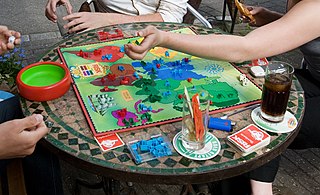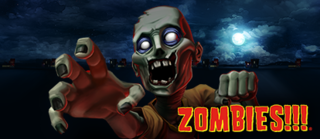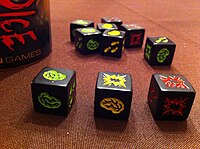
Steve Jackson Games (SJGames) is a game company, founded in 1980 by Steve Jackson, that creates and publishes role-playing, board, and card games, and the gaming magazine Pyramid.

Risk is a strategy board game of diplomacy, conflict and conquest for two to six players. The standard version is played on a board depicting a political map of the world, divided into 42 territories, which are grouped into six continents. Turns rotate among players who control armies of playing pieces with which they attempt to capture territories from other players, with results determined by dice rolls. Players may form and dissolve alliances during the course of the game. The goal of the game is to occupy every territory on the board and, in doing so, eliminate the other players. The game can be lengthy, requiring several hours to multiple days to finish. European versions are structured so that each player has a limited "secret mission" objective that shortens the game.

Trouble is a board game in which players compete to be the first to send four pieces all the way around a board. It is based on a traditional game called "Frustration" played on a wooden board with indentations for marble playing pieces and rules similar to Parcheesi. Pieces are moved according to the roll of a die using a contained device called a "Pop-O-Matic".

HeroQuest, is an adventure board game created by Milton Bradley in conjunction with the British company Games Workshop in 1989, and re-released in 2021. The game is loosely based around archetypes of fantasy role-playing games: the game itself was actually a game system, allowing the gamemaster to create dungeons of their own design using the provided game board, tiles, furnishings and figures. The game manual describes Morcar/Zargon as a former apprentice of Mentor, and the parchment text is read aloud from Mentor's perspective. Several expansions have been released, each adding new tiles, traps, artifacts, and monsters to the core system.

Give Me the Brain is a discard-style card game designed by James Ernest and released in 1996 by Cheapass Games. In the game, players assume the role of zombies attempting to complete their tasks for the day at Friedey's, "the fast food restaurant of the damned", yet they only have one brain to share between them. The game inspired several sequels, all set at Friedey's.

Zombies!!! is a tile-based strategy board game for two to six players. Zombies!!! won the 2001 Origins Award for Best Graphic Presentation of a Board Game, and Zombies!!! 3: Mall Walkers won 2003's Origins Award for Best Board Game Expansion.
The Great Brain Robbery is a board game designed by James Ernest and released in 2000 by Cheapass Games.

Zombies is a video game adaptation of the popular tile-based board game by Twilight Creations Inc, publisher of the original game. The game was initially to be developed by Big Rooster for PlayStation Network, Xbox Live Arcade and Windows PCs through Steam, with possible versions for the Wii and the Nintendo DS. However, only Windows Phone 7 and Windows 8 versions have been confirmed after development of the game was resumed and taken over by Babaroga.
Betrayal at House on the Hill is a board game published by Avalon Hill in 2004, designed by Bruce Glassco and developed by Rob Daviau, Bill McQuillan, Mike Selinker, and Teeuwynn Woodruff. Players all begin as allies exploring a haunted house filled with dangers, traps, items, and omens. As players journey to new parts of the mansion, room tiles are chosen at random and placed on the game board; this means that the game is different each session. Eventually the "haunt" begins, with the nature and plot of this session's ghost story revealed; one player usually "betrays" the others and takes the side of the ghosts, monsters, or other enemies, while the remaining players collaborate to defeat them.

Last Night on Earth: The Zombie Game is a survival horror board game that was first published in 2007. Players can play on the Hero team or as the Zombies. A modular board randomly determines the layout of the town at the start of each game and there are several different scenarios to play. Seven supplements have been released.
Demon Dice, originally published as Chaos Progenitus, is a collectible dice game for two or more players created by Lester Smith and Tim Brown.

Monopoly: The Mega Edition is a special variant of the popular Hasbro board game Monopoly. The game was first published on May 22, 2006 by Winning Moves Games USA in the United States. A UK version was adapted on October 1, 2007.

Mansions of Madness is a tabletop strategy game designed by Corey Konieczka and published by Fantasy Flight Games in 2011. Players explore a locale filled with Lovecraftian horrors and solve a mystery.

King of Tokyo is a monster movie-themed tabletop game using custom dice, cards, and boards, designed by Richard Garfield and released in 2011. A New York City-based edition, King of New York, was published in 2014. The game was re-released in 2016, with all-new artwork and characters.
Dead of Winter is a semi-cooperative survival strategy board game for two to five players designed by Jonathan Gilmour and Isaac Vega through Plaid Hat Games. The game is set in a post-apocalyptic, zombie-infested colony. Players are faction leaders who must work together to ensure the colony's survival through incoming zombies and lack of supplies. In addition, players have individual, secret win conditions that they must meet to be victorious.

Machi Koro is a tabletop city-building game designed by Masao Suganuma, illustrated by Noboru Hotta, and published in 2012 by the Japanese games company Grounding, Inc. Players roll dice to earn coins, with which they develop their city, aiming to win the game by being the first player to complete a number of in-game landmarks. Machi Koro has been published in eleven languages, with the U.S version being published by IDW Games and Pandasaurus Games.

Azul is an abstract strategy board game designed by Michael Kiesling and released by Plan B Games in 2017. Based on Portuguese tiles called azulejos, in Azul players collect sets of similarly colored tiles which they place on their player board. When a row is filled, one of the tiles is moved into a square pattern on the right side of the player board, where it garners points depending on where it is placed in relation to other tiles on the board.
Roll for the Galaxy is a dice game of building space empires for 2 to 5 players. Designed by Wei-Hwa Huang and Tom Lehmann, it was published by Rio Grande Games in 2014. Player dice represent their empire's populace, whom the players use to develop new technologies, settle worlds, and trade. It is a dice version of an older board game Race for the Galaxy.

Patchwork is a two-player board game created by Uwe Rosenberg. It was released in 2014.

Sagrada is a dice-drafting board game designed by Adrian Adamescu and Daryl Andrews and published in 2017 by Floodgate Games. Each player constructs a stained-glass window using dice on a personal 4×5 game board board with restrictions on the types of dice that can be played on each space. Players gain points by completing public and secret objectives for dice placements, and the one with the most after ten rounds is the winner.
















